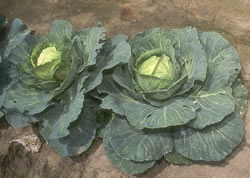
|
|||||||
How to grow cabbageCabbage has pale green leaves which spread out to form a firm edible head. It is highly nutritious and can be grown in the ground, on raised beds and also in containers. It’s easy to grow if it gets lots of water and sun.
Types of cabbageGreen cabbage is the most common type of cabbage and is available in different hues from almost white to blue-green depending on the variety. Varieties that mature early are juicy and tender but will not store well like later varieties. Red cabbage has wide leaves with silver-green edges and purple veins, and the heads have a deep violet-color inside. Red cabbage is commonly used to add color to salads and is used in cooked dishes too. Savoy cabbage has coarse leaves, and is grown for salads and slaw. The leaves are much thinner and very tender when compared to the other types. How to plant
PestsSome common pests which attack cabbage plants are the Imported Cabbage Worm, Cabbage whites, Cabbage Loopers and Cabbage maggots.
Applying oil soap spray will effectively control these pests. To make oil soap spray mix 2 tsp. vegetable oil with 1tsp. dish soap. Spray plants with mixture ensuring leaves undersides are covered. How to harvestCabbage should be harvested as soon as the heads are firm to the touch. Delay in harvesting can lead to split heads caused from too much moisture and will attract pests and diseases. Just cut the head from the stem. Small sprouts usually appear on stems after the main harvest period. These sprouts can be harvested when they are about 2-4 inches in diameter and firm to the touch. You can compost the stumps, or cover properly with mulch throughout winter. This allows you to save the seeds they produce come next spring.
|
|||||||
|
DISCLAIMER: We cannot guarantee that these links will work all of the time |
|||||||
Submit a Free Link | Advertise your Business | Privacy Policy

